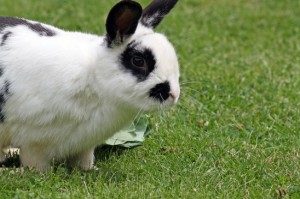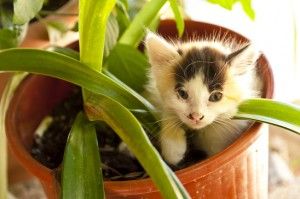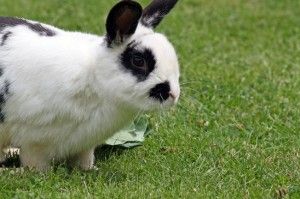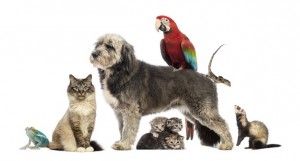Himalayan Rabbits: The Facts

Here are a few unusual facts about Himalayan rabbits:
In most cases, Himalayan rabbits are born with totally white or gray fur, and their markings develop as they age. The fur of a Himalayan rabbit is white with black markings on the tail, feet, ears, and nose. The black nose mark is a distinctive egg-like shape, and the other markings appear as if a white rabbit’s ears and feet have been dipped in black paint. Although black is the typical color of a Himalayan’s markings, some Himalayan rabbits have been specially bred to have white fur with differently colored markings. The different varieties are called blue, chocolate, and lilac.
Although most Himalayans have white fur, Himalayan rabbits that are raised in colder climates can have all-black fur. Some sources even claim that a Himalayan rabbit can develop a dark spot on its fur overnight if the fur has extended contact with a cold object during a winter night. Living in a very warm climate can cause a Himalayan’s dark markings to fade and can even lend a yellowish tint to its white fur.
The Himalayan rabbit is found in homes throughout the world, and it goes by many different names. For example, in some parts of the world, this breed is known as the Black Nose rabbit. In the U.S., breeders often refer to this type of rabbit as a “Himmie.” Himalayans are among the oldest rabbit breeds but were not brought to the United States until the early 1900s. Although these rabbits were once valued primarily for their fur, they are now appreciated as pets and in competitive shows held by breeders.
Himalayans are considered one of the best breeds for pets, especially in homes with children. These rabbits are typically very mellow in temperament. They appear to enjoy interacting with humans and do not mind being handled. In fact, it is said that Himalayans typically do not scratch or bite humans. The Himalayan’s unusually slender body shape and small size, ranging from 2 to 4 pounds, makes it easier to pick up and hold than other types of rabbits. In fact, only dwarf rabbits are smaller than Himalayans.
This type of rabbit is sometimes compared to a cat because of its slender body type. Like cats, Himalayan rabbits are intelligent enough that they can learn to recognize their names and to use a litter pan. In another connection with cats, it is said that some individual Himalayans enjoy resting on their owner’s laps. Himalayans also typically engage in play with standard rabbit toys and may play hiding games with their owners. Himalayan rabbits often live at least 5 years.
Here are a few unusual facts about Himalayan rabbits:
In most cases, Himalayan rabbits are born with totally white or gray fur, and their markings develop as they age. The fur of a Himalayan rabbit is white with black markings on the tail, feet, ears, and nose. The black nose mark is a distinctive egg-like shape, and the other markings appear as if a white rabbit’s ears and feet have been dipped in black paint. Although black is the typical color of a Himalayan’s markings, some Himalayan rabbits have been specially bred to have white fur with differently colored markings. The different varieties are called blue, chocolate, and lilac.
Although most Himalayans have white fur, Himalayan rabbits that are raised in colder climates can have all-black fur. Some sources even claim that a Himalayan rabbit can develop a dark spot on its fur overnight if the fur has extended contact with a cold object during a winter night. Living in a very warm climate can cause a Himalayan’s dark markings to fade and can even lend a yellowish tint to its white fur.
The Himalayan rabbit is found in homes throughout the world, and it goes by many different names. For example, in some parts of the world, this breed is known as the Black Nose rabbit. In the U.S., breeders often refer to this type of rabbit as a “Himmie.” Himalayans are among the oldest rabbit breeds but were not brought to the United States until the early 1900s. Although these rabbits were once valued primarily for their fur, they are now appreciated as pets and in competitive shows held by breeders.
Himalayans are considered one of the best breeds for pets, especially in homes with children. These rabbits are typically very mellow in temperament. They appear to enjoy interacting with humans and do not mind being handled. In fact, it is said that Himalayans typically do not scratch or bite humans. The Himalayan’s unusually slender body shape and small size, ranging from 2 to 4 pounds, makes it easier to pick up and hold than other types of rabbits. In fact, only dwarf rabbits are smaller than Himalayans.
This type of rabbit is sometimes compared to a cat because of its slender body type. Like cats, Himalayan rabbits are intelligent enough that they can learn to recognize their names and to use a litter pan. In another connection with cats, it is said that some individual Himalayans enjoy resting on their owner’s laps. Himalayans also typically engage in play with standard rabbit toys and may play hiding games with their owners. Himalayan rabbits often live at least 5 years.









